Two years in the making, the Living Alleys Toolkit establishes the framework, strategies and processes for creating a network of plazas, gardens, and active public spaces in traffic calmed alleyways throughout the Market-Octavia Plan Area. And it’s a toolkit which can be applied to other areas of the city as well.
Two prototype designs, one for a “Shared Street” in the 200 block of Ivy and another for a mid-alley “Living Zone,” demonstrate the various elements, phasing, and cost commitments which can be tailored to, and evolve with, the availability of funds.
Two million dollars ($2,000,000) is currently earmarked to kick-start living alley improvements within the Market Octavia Neighborhood, and a Community Challenge Grant program and outline for leveraging additional partnerships are about to be put in place.
And later this week, the toolkit, which includes a DIY survey kit for evaluating potential projects and detailed cost estimates for each element of an alley’s transformation, will formally be unveiled.
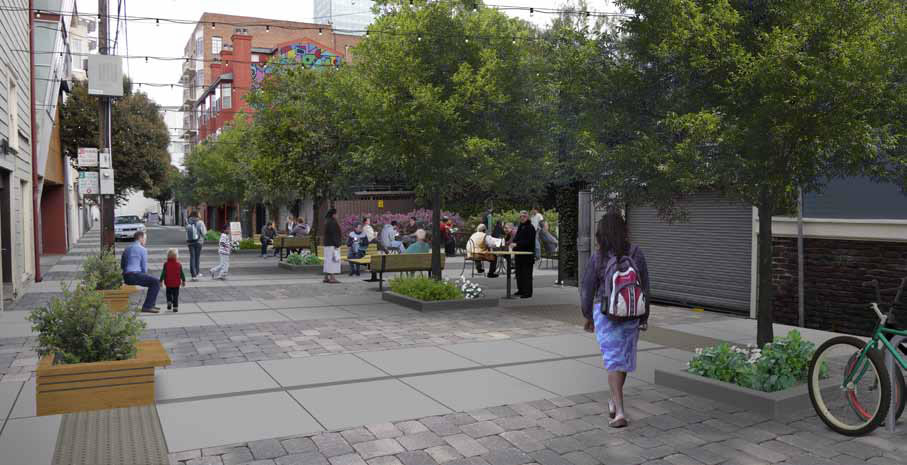
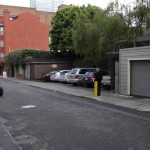
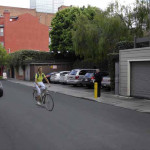
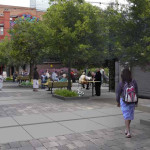
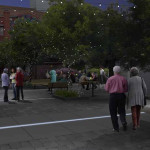
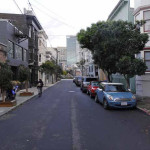
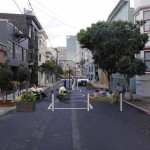
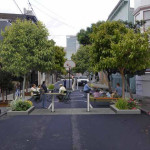
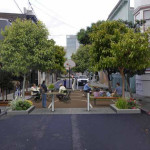
Seems flat out insane to be choking off these little arteries and vessles throughout the city to overly congest the major roadways. City should maybe focus on making these things dedicated bike routes?
@eddy, that’s an interesting concept. In addition to the city possibly choking off these alleys with this plan, they’re also attempting to downsize various streets with dedicated bike lanes – by removing traffic lanes. I believe that plan will also congest various areas of the city which are dense and growing more dense almost monthly. I have nothing against bicycles and bicycling.
Its an interesting concept to see if various alleys can, as you mention, be safe havens for bicycle traffic and bicycle commuting in addition to pedestrians, while preserving the main streets for motorized vehicles.
Everybody gets what they want, various commuters are protected from the issues with blending such various commute modes all together, additional self-inflicted congestion is alleviated, and we hopefully improve the ability to get around the city by various means. This could be very cool.
Many people access their garages from alleys. I also serious doubt they there is enough networks of contiguous alleys to consider
It does seem that there are not enough of these alleys in SF that don’t serve garages, as Zig mentions. This is a really nice idea, as are Eddy’s and Cool Names’, but in the end we need more public transit to really make any of this work. A lot more, preferably underground (which I do realize is difficult in a seismically active area). At our current growth rate, everything else will just be a half measure.
@Can’t think, couldn’t agree more. These alleys still maintain the same auto access as before–only difference being garage owners in the “mid-alley” proposal will have to know which side of the cul-de-sac’d street to enter. These alleys in the Mission have never been the right scale for fast through traffic and only come into play those days I can’t get a parking spot right by Farolito. Give the streets over to kids already–about time kids can play basketball or whatever and be healthy, outside, and having fun in the streets again.
How about they paint them red and only allow muni busses on them? Toolkit. SFMTAint can’t stop dribbling out little distractions while meantime the roads are full of holes and the busses lumber late through red lights.
No real network plus no traffic lights at intersections with alleys for the most part. So just a crazy idea. Nevertheless, choking off these vessels is a bad idea. The Annie alley thing is a disaster and has caused major traffic congestion in that area at rush hours.
They want to spend money to encourage children to play in streets with cars, based on their pictures. Cars don’t go nearly as fast in these alleys as on main streets. Often they are looking for parking or going to/from their garages. In SoMa many of the alleys are service streets for commercial buildings that front on the main streets.
A few alleys are well located for cycling. Minna runs from 9th to 4th in SoMa. One of many reasons that 4th should be the priority north-south bike route in SoMa.
Great idea. This is progressive urban development making where we live better. I encourage everyone thinking or in some cases expressing “that’s a bad idea” really take a moment to see beyond the car and old paradigms.
Seeing “beyond he car” is not acknowledging that the car is an integral part of these neighborhoods and alleys. It’s fantasizing about your little utopia.
I believe that these are shared spaces for pedestrians and cars. Cars are not banned, but pedestrians are given more access. Similar to the space in front of the Blue Bottle garage on Linden, you can drive there but it’s a not a major throughfare, so it’s mostly pedestrian.
I agree with you Eric. I think this could be great.
cars are not an old paradigm. the number of cars in SF is increasing. cars will contnue to be important, but hopefull they will switch into all alternative energy cars and eventually self driving, but we do need to protect the lanes for cars to ensure that people can move throughout the city.
These jewel box designs that eliminate streets and parking faster than the city can improve mass transit are just wonderful. I wonder how much improved bus / Muni service $2 million buys.
I am still waiting for a permanent solution to all the MUNI station escalators that are constantly not operating at various station locations. It has gotten to the point to where I am shocked when one of them is actually in operation.
Given the block size in SoMa, I’ve always felt the opposite should happen – these alleys should be turned into full-fledged (but small-scale) streets, equivalent to the E-W avenues in midtown Manhattan. Install lights at their intersection with major streets, re-connect discontiguous segments, and pretty soon you have a much more walkable street grid.
We are slowly adding lights at the intersections of the small streets/alleys and the main streets. The ones along Hawthorne have been there a long time, a few years ago one was added on Folsom at Russ, and one is planned on Second at South Park. They are all mostly for pedestrian safety.
One problem is that these small streets get over-committed. Hawthorne St is supposed to be the new route for cars on Montgomery in the FiDi to get to the eastbound Bay Bridge (Montgomery, New Montgomery, Howard, Hawthorne, Folsom, Essex, Bay Bridge). It was the only way they could justify closing the left turn from 2nd onto Folsom. Without eliminating that left turn they can’t fit in cycle tracks. Take a walk on the narrow sidewalks of Hawthorne and imagine the chutzpah it takes to route FiDi traffic to Oakland through there.
So, be careful what you ask for.
@Jake, walking Hawthorne quite a bit, I’ve also noticed that folks headed down the peninsula or headed west in general use the street as well to turn right on Harrison to jump on the 80 onramp at 4th or just keep heading west on Harrison. I’ve almost been clipped a few times crossing Harrison (walking southbound on the west side of the street) by people turning right and looking left to watch oncoming traffic.
Hawthorne is one of those weird tight streets where people use it heading in multiple directions…
Should’ve kept the Embarcadero freeway!
totally agree
Yes!
thats a major bummer if you have a garage on that alley
ahhh, our city planners in their deluded utopia…
let’s do some “traffic calming” and close a street down, hey, we can put a parklet in; couple of planters, some flags, bunches (designed so homeless can’t sleep in them) don’t forget the bike racks, hey we got another park!!
Muni, transit, auto access, “What’s that?”
Garages have ruined this town.
In those 2 sets of pictures alone I count 11 parking spaces gone. And I hope there aren’t actually as many people unemployed and available to hang around in converted alleys as depicted. So we are planning to take away desperately needed parking for cars that exist to create spaces for hipsters who may not exists to hang out all day. It’s such a San Francisco idea of itself.
Each of those cars in the “before” pictures can now be seen circling all of the surrounding streets 20 times each time it tries to find street parking – adding to the traffic congestion that produces more pollution in the immediate area.
If I lived around there I would be strongly opposed to this kind of idea. Not only does getting into your garage become evem more difficult, but now you have to listen to a basketball bouncing around. Car sounds generally fade into the background of the city, but a basketball’s thump does not.
Also…love the fact that in the top rendering they didn’t remove the street permit parking signs.
yeah! gross! next thing you know you might have CHILDREN PLAYING outside your window! have you heard children play? they’re always squealing and yelling. that’s why living near schools causes such blight. a basketball court would be used well into the night too! why just the other night i was trying to sleep when a BASKETBALL GAME happened right outside my window! i went down there and popped their ball. stupid kids and their night basketball. it’s literally KILLING the city if we improve these poop-filled alleys.
Actually, I agree that the ‘thump’ of a basketball is one of the more annoying urban sounds.
we live in a city. get over it.
Thank you for your reasoned response, which was every bit as respectful as mine. I shall remember your rejoinder the next time you complain about traffic / sewage smells / homeless people / etc. Clearly, “we live in a city. get over it” is the most useful comment one can make; nothing more constructive or useful (e.g., possible solutions, or even an acknowledgment of the issue) could possibly be offered to the conversation.
More annoying than a garbage truck? idling 18-wheeler? car horn? I beg to differ. Buy some earplugs.
Concept projects like this as well as the allowance for conversion of unused garage space to commercial are excellent, and hugely beneficial to the city/neighborhoods they exist. Traffic/public transit, and living alleys may be mutually exclusive, but that doesn’t mean there isn’t room for constant, or ongoing improvement for the former. Moving 1 million plus people around a small section of a small city is forever complicated.
Help us self driving cars; you’re our only hope.
You’re all becoming such nattering nabobs of negativity. Truth is, the alleys in Market/Octavia are perfect for this kind of treatment. They are very narrow, slow, and quite discontinuous. They don’t serve people trying to drive through, and for the same reason don’t work well for cyclists (who would confront the same problem as cars do trying to cross busy arterials without traffic lights or stop signs). Just take a look at Linden Alley @ Gough to see a well designed treatment that makes it a joint pedestrian/car use area. You can still access garages, but cars and peds are put on an equal footing. It’s quite pleasant for both. Any of these projects has to respond to the unique circumstances of the place…whether parking needs to be accessed, whether you want to permanently sacrifice some street parking for other uses, whether you could cut off car access completely in any areas. All of this would be subject to tons of community (read immediate neighbor/landowner) involvement, as any of these projects are very easy to shoot down in our consensus driven planning process.
SOMA and Mission alleys/small streets tend to have more connectivity, but it is still rare that anyone in an auto wants to drive for more than a block on them before getting onto an arterial. For that reason I DO often ride my bike on streets like Alabama and Florida in the Mission rather than on Harrison or Folsom, as I can ride down the middle without bothering anyone, and car speeds are (generally) no faster than bikes, except for the occasional testosterone fueled butthead…. These kind of streets are often well served by treatments that reinforce that they are slow streets for cars, like raising the entrance of the street to sidewalk level, as has been done in several locations, such as Shotwell between 17th and 18th.
Amen!!
I wholeheartedly agree with “curmudgeon”. I think this is an excellent idea/program for the Market-Octavia area. Its an “inclusive approach” — sharing the street with cars, bikes and people — that can really make optimum use for the many alleys within that neighborhood and introduce a finer grain of “livable” urbanism that everyone can enjoy and benefit from.
Architect Winslow, who’s now with the Planning Dept., is the perfect expert to help implement this program, judging from the extremely well-designed little gem that he did along a section of Linden (near Gough) in front of Blue Bottle — in which, by the way, every garage is still accessible and autos can still travel through the entire alley.
This kind of more permanent/durable public improvement would definitely be a step up in so-called “tactical urbanism” than the existing (temporary) “Parklets” program.
Traffic calming. What does that even mean? Seems to me traffic calming means more traffic and fewer places to park. If the goal is to make our streets safer, actively enforce traffic laws. Issue traffic tickets to discourage cars from speeding and to encourage complete stops at stop signs. Issue traffic tickets to discourage cyclists from running stop signs and pedestrian from jaywalking. Living alleys, parklets, and plazas aren’t likely to change the behavior of drivers, cyclists or pedestrians. Travel routes might be altered, but behavior is not likely to change.
Unfortunately active enforcement is more costly and less effective than traffic calming. And yes, traffic calming measures do affect people’s behavior for the better.
These alleys are too narrow to support high speeds and they’re so short that higher speeds do not provide any significant benefit.
I find most “traffic calming” efforts infuriating, especially the city’s insistance on timing lights to make one stop every block and those awful humps. They do anything but “calm” me.
joking aside, you’re absolutely right. The reason some people gun it and speed ahead is to try to make it through at least one green light… If you get stopped block after block after block, it gets infuriating. If instead you can go 4 or 5 blocks before the next red – that is less annoying.
In the past people have talked about “traffic sewers” which I find an obnoxious anti-car term, but my question is, with some streets, why not make them designed to accommodate large amounts of traffic and time the lights so that drivers are encouraged to use those streets instead of alleys or residential lanes like the ones shown here?
At one point in my life I lived 2 blocks off of Wilshire Blvd between Westwood and the Los Angeles Country Club, and we never got any spillover traffic because Wilshire was where drivers went to get cross town. Our street maybe saw 15 vehicles an hour, while nearby Wilshire was 3 lanes each direction with lights computer controlled so that you could get from Wilshire and Westwood to Wilshire and Santa Monica boulevard in less than 7 minutes. Even “traffic sewers” have their need, and Wilshire is hardly a sewer with condo prices along that stretch well in excess of 2 million for starters.
SF has streets with timed lights, e.g. Bush, Pine, Fell, Oak. All of those are timed to the speed limit. The timing tends to work on segments of a main through street and not so well where they intersect with another one, like these do with Divisadero and Van Ness. I don’t think of any of these as traffic sewers, but that’s about the function of San Jose Ave in the Bernal cut and Alemany as it parallels 280, not to mention all the freeways.
There are also some streets with lights timed to bike speeds (13-15 mph), SFMTA calls them green wave. The first was on ten timed traffic signals on Valencia Street, making it our first official (green) bike sewer.
Traffic calming is designed to slow speeds naturally, whether it’s making lanes more narrow or timing lights so that 20mph provides the smoothest drive. People will drive more slowly in an alley with a narrow planter-lined lane than a wide one with only a curb around it. City planners do use data and studies to make these changes, and I agree that speed cameras at major thoroughfares seems like a good solution to slow people down. However, as someone who uses all modes to get around, a greener streetscape is always appreciated.
Because the cyclists and the pedestrians are the primary threat in SF.
Yep.
Driving surrounded by 4,000 pounds of steel and plastic and 200 horses at your toe make people sociopaths.
Taking each alleys vehicle access into consideration, I think these are great concepts to incorporate and expand upon.
While I typically endorse these types of public spaces, there is one next to my house on Minna & Russ called Tutubi Plaza, which is the best place in all of San Francisco to mainline some heroin with likeminded folks in peace.
I think people generally get that this has the potential to be a win-win-win situation for all involved, i.e., pedestrians/bicyclists/motorists along with property owners and the general public all benefit through this kind of bonafide “sharing economy” Planning initiative — only subject to their ability/willingness to effectively organize and if the entitlement process can truely be streamlined and supportive behind them.